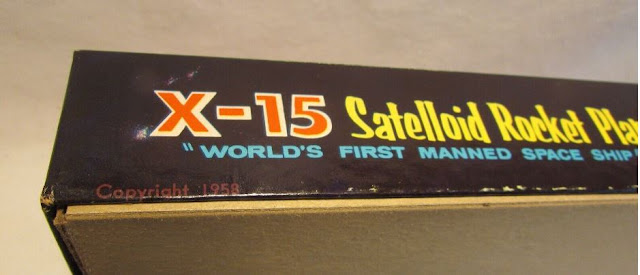Hi Woodsy,
In 1959 Aurora released a 1/48th scale kit of the North American X-15 supersonic research aircraft. The initial version was moulded in white and clear plastic - you had to paint on the red trim.
There were only eleven parts in the original kit, plus a two-part display stand in clear plastic. There was no undercarriage or cockpit detail, and the markings were engraved.
The kit was later revised, an undercarriage added, and the model was moulded in black plastic. This version was given new box art.
The box top said X-15 Satelloid Rocket Plane, and 'World's First Manned Space Ship'. Box art for the first version was by Jo (Josef) Kotula (1910-98), and shows the X-15 high above the Earth.
The term Satelloid covers low altitude satellites that need engines to maintain their altitude. A term I only know from its use on the Aurora kit box.
The kit number was 120-.98, the suffix meaning it originally sold for 98 cents. The copyright dates on the box and instruction sheet were 1958.
The Aurora kit came out the same year that the real X-15 first flew - two years before the first manned space flight. The X-15 only went in to space between 1962 and 1968, a year after the first manned rocket flights.
The three North American X-15 rocket planes made a total of 199 flights, between 1959 and 1968. Of the 199 flights, 13 exceeded an altitude of 50 miles, or 264,000 feet, and therefore crossed in to space under the definition of space used by the US Air Force.
The pilots of these flights were therefore awarded Astronaut Wings. The five USAF pilots got their Wings in the 1960s, but the three civilian pilots in the test programme had to wait until 2005 to receive their civilian Wings from NASA, by which time only one of the pilots was still alive.
Only two of the flights, both in 1963, exceeded 100 kilometres, or 62 miles, which is the definition of space used by the Federation Aeronautique Internationale/International Aviation Federation. The Wikipedia page for the X-15 includes a list of all 13 space flights.
While the original Aurora kit is now a rare piece of modelling history, in a totally fictitious colour scheme, it would still be fun to paint up a normal X-15 model to match the box art. Even better, display it alongside a black version.
A word of warning. A number of on-line sales listings for this kit show the revised version in black plastic, with undercarriage, in the original issue box - as far as I know this is not correct.
Four photographs from Worthpoint.
Paul Adams from New Zealand






Never saw the kit in my local model shop in tne UK, but always wanted this and the Aurora F107. The early Aurora kits were not very accurate but were great fun and easy for kids to make. I do remember having their F7U Cutlass and F94C Starfire.
ReplyDeleteGeeky facts - The futuristic looking Aurora X-15 kit was kitbashed by Derek Meddings team for the Thunderbirds episode 'The Imposters' into a Navy fighter seen launching from the deck of an aircraft carrier. Painted blue with a B58 Hustler pod added underneath, tailplanes removed and a new tailplane added (from a SAAB Draken?), a new larger bubble canopy and a long nose probe taken from some other kits.
Two versions of the X-15 are also used in the 1959 Japanese Toho movie 'Battle in Outer Space' as zero launch length (zell) fighters launched from ramps . One with pods added to the wing tips and a second version with longer wings armed with atomic heat cannons !!???!!
An amazing lost kit from a golden moment in time. I had the regular black plastic X-15 kit, as did probably every self-respecting boy at the time, and loved it. But the white one would have put me over the edge! SFZ
ReplyDeleteAlthough the X-15 was one of my favorites as a kid, alas, my only X-15 now is a small tin-litho one from Linemar (Marx's Japanese subsidiary)
ReplyDeleteThanks. Painting a normal X-15 to match the vintage Aurora box art would make for a great looking model, especially if you had a normal black version to go with it. Both posed in front of a globe, flying high above the Earth. The white version would have to be made undercarriage up, as the early Aurora kit did not have any landing gear.
ReplyDeleteThis would have made a great Project SWORD toy like the Dyna Soar. Lovely kit Paul.
ReplyDelete